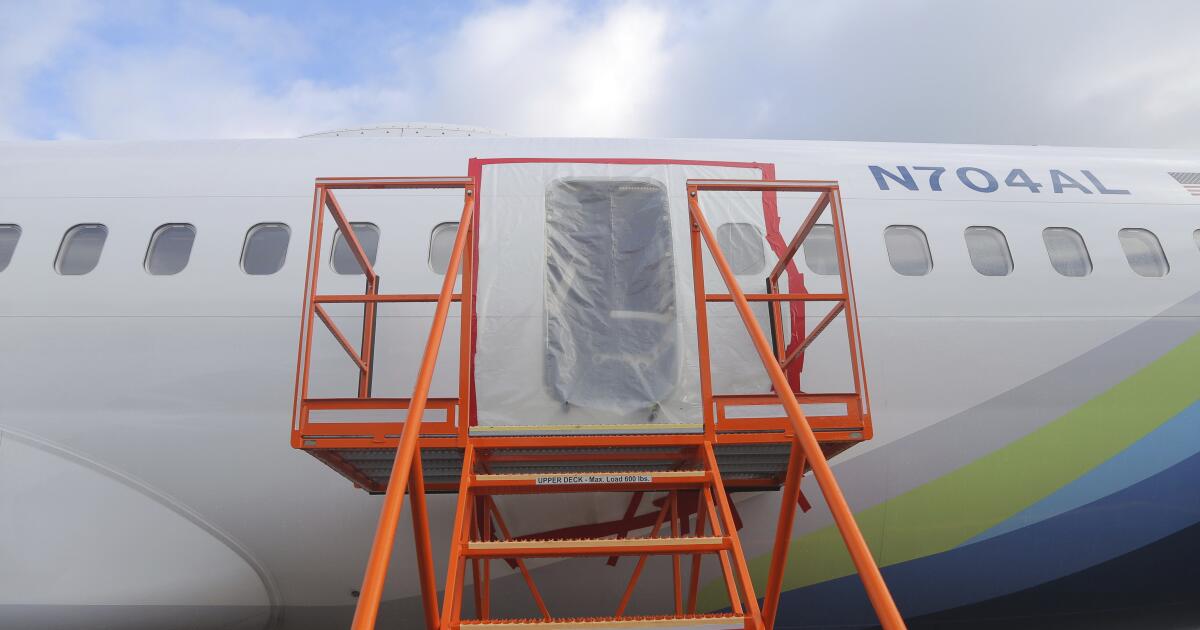Why do planes have door plugs? And other questions about the Alaska Airlines blowout, answered
The landing gear was stowed, the plane was climbing to cruising altitude, and then a segment of the wall exploded out of the rear cabin of Alaska Airlines Flight 1282 on Friday night, just 20 minutes after the plane took off from Oregon’s Portland International Airport airport en route to Ontario, Calif.
No passengers were seriously injured in the incident, which occurred as the Boeing 737-9 Max was 16,000 feet off the ground, and the pilots managed to safely land it back at the Portland airport shortly after.
The event has raised a number of questions. The most crucial is just how this kind of failure, in which a door plug installed to replace an emergency exit was ejected out of the side of the pressurized cabin, could occur in a commercial plane. Federal regulators at the National Transportation Safety Board are actively investigating the incident but have not yet announced any findings.
But what exactly is a door plug in the first place? How did the cockpit voice recording end up being erased before anyone could listen to it? The Boeing 737-9 Max has been grounded worldwide pending the results of the investigation, but how can you figure out what plane your flight is going to be on in the future? And how exactly did an iPhone that got sucked out the gaping hole in the plane survive the fall to Earth?
These questions, at least, can be answered.
What is a door plug? Do a lot of planes have them?
The part of the plane fuselage that failed Friday was called a door plug and is not unique to the 737-9 Max or other Boeing planes.
The number of required emergency exits changes based on the number of passengers a plane can hold. The original design of the 737-9 Max had two additional emergency exits toward the rear of the plane, in addition to the exits over the wings, at the rear, and near the cockpit. Some international customers of the 737-9 Max have been flying the planes at maximum capacity, which requires all the original emergency exits in place.
Alaska Airlines opted to fly its 737-9 Maxes with fewer passengers, which meant it didn’t need those additional emergency doors.
Robert Ditchey, an aviation expert and former airline executive, explained the logic behind replacing the doors with a plug.
“One would think the more the merrier” when it comes to emergency exits, Ditchey said, but exit doors with embedded slides or life rafts add weight to a plane and cost extra to maintain over the life of the craft.
After the airline ordered the modified plane, the company that manufactures its fuselage, Spirit AeroSystems in Wichita, Kan., took out the original door and added the door plug in. That modified fuselage was shipped to Boeing “fitted but not completed,” according to Reuters, which allows Boeing to remove the plug and use the hole in the side to access the cabin of the plane, in order to install interior components. Boeing ultimately reattached the door plug in its facility, then delivered the craft to Alaska Airlines.
Why would a door plug just fly off like that?
The NTSB has yet to determine the specific cause of the failure, but one possible culprit is some flaw in the bolts that were holding the door plug onto the rest of the airframe. On Monday, United Airlines announced that it had found loose bolts and other installation issues on the door plugs of its own 737-9 Max planes.
“We don’t know what failed,” Ditchey said, mentioning the possibility that some bolts could have been missing, the wrong size, improperly tightened, or could have mechanical flaws in the metal. He added that there could have been a structural failure in the frame of the craft, but said that he thinks that less likely.
In his view, this points to a design flaw in the door plug itself. The doors in a commercial plane are designed specifically to be un-openable while the cabin is pressurized, and designed to withstand the pressure of the cabin. Even without bolts or a latch holding it in place, a passenger would not be able to open the emergency exit on a plane that was fully pressurized. To ensure that they can’t blow out, like the door plug on the Alaska flight, they are built like wedges: larger on the inside than the outside, so the cabin pressure fits them snugly into place.
“The plug is in my opinion a bad design, because it can blow out and did blow out in this case,” Ditchey said, since it appears to have been bolted on from the outside, rather than wedged against the frame from within. “That troubles me greatly.”
Boeing and Spirit AeroSystems said that they could not comment on the specifics of the door plug assembly given the ongoing NTSB investigation into the failure.
Accidents over the last half a century in which the airplane cabin depressurized have been mostly attributable to baggage hold door failure, particularly with the now-obsolete DC-10 airliner, and fuselage metal fatigue, rather than failures in the main cabin doors.
What’s the deal with the flight recorder?
When Jennifer Homendy, chair of the NTSB, spoke about Friday’s incident at a news conference over the weekend, she brought up a very specific frustration: The cockpit voice recorder in the plane had automatically erased the recording from the incident.
Nobody turned the recorder off for safekeeping, and they are programmed to retain only the most recent two hours of audio, which is then automatically overwritten. As The Times reported:
Homendy was visibly exasperated by the loss of the black box recording. She noted that it was a “very chaotic event” when the plane landed and officials set up an emergency operations center.
“The maintenance team went out to get [the cockpit voice recorder], but it was right at about the two-hour mark,” she said, later adding: “We have nothing.”
The two-hour setup of the recorders strictly follows FAA guidelines, but proposed rules would extend the recording time to 25 hours, in line with current European regulations.
How can I tell what kind of plane I’m about to get on for my next flight?
Most airlines show the type of plane that you’ll be flying in when you view the flight information on their booking site. Third-party websites such as FlightAware and FlightStats also show the model of plane being used for a given flight.
Airlines that have purchased the relatively new 737-9 Max have grounded the plane for the time being, though, so there’s no risk of getting on a similar model to the plane in Friday’s incident. The earlier version of the 737 Max, the 737-8, is in wide use in airline fleets around the world but has a notable blemish on its safety history — those planes were grounded in 2019 after two deadly crashes that killed 346 people, but they were deemed safe to fly in 2021 and have been in heavy use since.
How the heck did an iPhone survive the fall from 16,000 feet?
As Sean Bates took a walk around his home on Sunday, he stumbled upon a remarkable artifact of Friday’s accident: the iPhone of a passenger that had been sucked out the hole in the plane.
The phone appears to have been found in the grass, which made for a soft landing, but still: Three miles is a pretty long way to fall.
Luckily, a little physics provides the answer. All objects have a certain terminal velocity that they reach when falling through the air, based on how their size and weight interact with wind resistance. Small, heavy objects reach a higher terminal velocity than big, lightweight ones — think a baseball versus a piece of paper.
As Wired calculated in an article in 2011 after another incident of an iPhone surviving a fall from the skies, the small weight of the handset means that its speed when falling maxes out at between 27 and 95 mph, depending on whether it’s tumbling, falling flat or falling edge-down. As anyone with an iPhone can attest, even a much shorter drop can be fatal for the phones when the target is a concrete sidewalk, but with spongy grass serving as a shock absorber, the iPhone (apparently) just didn’t pick up enough speed to be smashed to smithereens. It can’t hurt that the unlucky passenger had their phone in a protective case.
What happened to the door plug?
At Sunday’s news conference, NTSB Chair Homendy said that the agency had recovered the chunk of airplane from the backyard of a home in Portland, Ore., after the agency was notified by a schoolteacher named Bob.
“Thank you, Bob,” Homendy said. The agency later posted a photo of the debris on its Twitter account.







